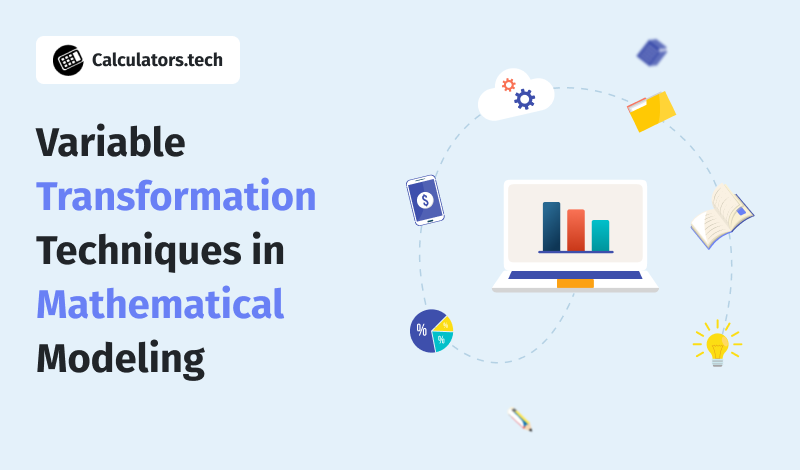More often in mathematical modeling, the management of the change in this respect in the different variables is a significant facet in the precision and the applications of models that span the field of statistics, economics as well as engineering. Specifically, this article discusses the importance of special variable transformation techniques in terms of their use and influence on selected mathematical models.
Understanding Variable Transformation
Variable transformation mainly reflects the changes in the scale or the kind of variables applied in the mathematical model with the effect of satisfying some certain assumptions or enhancing the model. All these transformations are used when there are problems like non-linearity problems, heteroscedasticity problems, or non-normality problems of data which raises questions on the measurement of statistical differences such as those based on linear regression.
Types of Variable Transformations
- Logarithmic Transformation: Of all the transformations, logarithmic transformation is popular as it involves replacing a variable by its natural logarithm, ln(x)\ln(x)ln(x). It is especially helpful when one is working with situations where the distribution is not normal and may even be skewed or where data is growing exponentially.
- Square Root Transformation: This transformation x\sqrt{x}x is useful in applying transformation in a condition with variance and for the data which has a quadratic relationship between the variables.
- Box-Cox Transformation: Another more general method is the Box-Cox transformation concords data towards being standardized, i.e., normally distributed. It is defined as:
- Inverse Transformation: 1x\frac{1}{x}x1 changes the variables to help in option dealing with data where under the variability of the data, the smaller values are scattered more than the large values which helps in an option of handling heteroscedasticity.
Application in Linear Regression Models
For example in the linear regression model, variable transformation is used in a way that best fits the model assumption like LINEAR, NORMALITY, and CONSTANT VARIANCE. For example, if the overall relationship between the variables does not seem linear, while in fact, the variables are highly related, applying the logarithm or square root transformation to one or more of the variables will linearize the relationship, and thus, enhance the modeling process.
Using a Linear Regression Calculator
A linear regression calculator developed by calculator online simplifies the application of these transformations by providing immediate feedback on the impact of different transformations on the model's performance. Researchers and analysts can input data, select transformation methods, and observe how these changes affect the regression coefficients, R-squared values, and other metrics. This interactive tool facilitates quick experimentation with various transformation techniques, enabling data-driven decisions in model building.
Practical Steps for Variable Transformation Using a Linear Regression Calculator
- Input Data: Start by feeding the given data set to the linear regression solving tool. Make sure that the data being collected contains the dependent or the independent variables that you would like to test.
- Initial Model Assessment: The first one is to carry out ordinary linear regression for a start in order to get a feeling of what the situation is like without carrying out any transformation on the data. Pay attention to the regression coefficients The coefficient of multiple determination (R-squared values) and residual plots should be noted.
- Select Transformation: After the first assessment, the right variable transformation is selected with respect to a certain type of problem (e. g. , non-linearity, heteroscedasticity). These transformations range from logarithmic, square root, Box-Cox, and are calculated through the reciprocal transformation or inverse transformation options available on the calculator.
- Apply Transformation: Perform the selected transformation to the chosen consistent variables. Changes relating to these commodities shall be reflected within the calculator with a view of updating the model accordingly.
- Re-assess Model: Assess the original and the modified model based on the new regression outcomes. This will be an indication of the efficiency of the newly transformed model when compared to the initial model by the new coefficients of determination, R-squared values, and the residual plots of the newly transformed models.
- Iterate as Needed: If the first transformation does not significantly enhance performance, try other transformations or a blend of transformations to solve the problem. The repeated cycles benefit in identifying the best way of setting up structures that can improve the performance of the model.
Real-World Applications and Benefits
Variable transformation techniques are applicable in various fields since they contain nearly every form of data a person might come across. For example, in finance, the adoption of spatial relations might enhance financial ratios or growth rates by removing noise from the algorithm. Now as to the environmental sciences, such transformation can be helpful in attaining the compliance with the regulatory standards by fixing the concentrations of the pollutants in a way that allows the account for the necessary statistical assumptions.
The benefits of using a linear regression calculator in this context are manifold:
- Efficiency: Applying transformations and testing them is made much easier and faster using the calculator; it is much easier and quicker than calculating them manually.
- Accuracy: Therefore, it aids in providing feedback regarding the consequences of the transformations on the model and outlines whether or not the chosen methods are beneficial in enhancing the model.
- Ease of Use: Such interfaces allow such calculators to be used by different categories of users of statistics with little or zero interference from the users.
Conclusion
These techniques are some of the more effective and important tools in the hands of mathematicians and data analysts for fine-tuning mathematical models. Whether used to resolve concerns over data distribution or to improve the presentation of models for linear regression, these transformations constitute critical components towards robust and accurate statistical analysis. By using a linear regression calculator, users are able to apply these techniques with greater success and more adjustments, leading to the improvement of results obtained from the data.
By adopting variable transformation, the professionals prevalent in different fields can enhance current mathematical modeling to incorporate high variability in real-life data.
